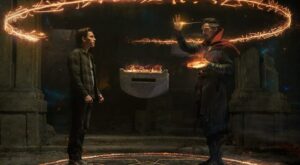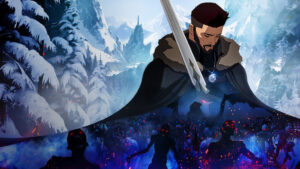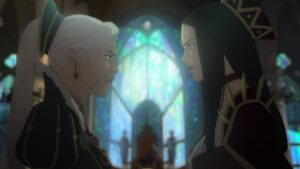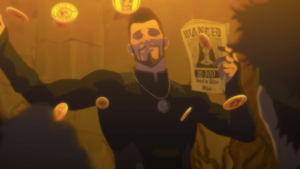Considered by many the Holy Grail of long-awaited movie trailers, the first official teaser for Spider-Man: No Way Home finally dropped last night after several tiresome months of pleading from fans; and much like the Holy Grail itself (at least if Indiana Jones And The Last Crusade is to be believed), it’s maybe not the flashiest thing in the world. Not, in my opinion, deserving of all the drama that surrounded its release and its premature leak. But at this point, I honestly don’t think the content of the trailer mattered that much. This thing was going to be big no matter what, simply because of the hype that had been built up around it, and the potency of name recognition.

Now, as sacrilegious as it may be to write these words, Spider-Man: No Way Home is not one of my most-anticipated MCU movies; not even close. I’m excited for all the Multiverse stuff because that’s more my groove, but it’s the thought of everything in between involving the unrealized potential of Tom Holland’s Peter Parker that gives me pause. I’m happy for everyone who’s happy to see that version of the character again; I’m just more intrigued by the possibility certainty of Tobey Maguire and Andrew Garfield appearing as Variants of Peter Parker pulled from their own universes into the MCU timeline.
And this trailer gives me just enough of what I needed to hold my interest in No Way Home – Multiverse shenanigans involving all our favorite past iterations of iconic Spider-Man characters who have somehow never been reinvented for the MCU. Alfred Molina returns as the 2004 version of Doc Ock from Spider-Man 2, looking just as fabulous as always even though his mechanical tentacles are very obviously all CGI this time around, and we don’t really get a clear shot of them. We can hear Willem Dafoe’s Green Goblin laugh for the first time since 2002’s Spider-Man, and he’s even still using his original pumpkin-bombs. There’s hints to Jamie Foxx’s Electro, Sandman, and a blurry shape that is possibly Lizard.
That’s a pretty awesome team of super-villains right there, just one member short of a true Sinister Six line-up. For Tom Holland’s sake, I hope one of his own villains completes the team; preferably Mysterio. It would be kind of awkward if in two whole solo movies he didn’t have a single villain worthy of making the cut. But that could be attributable to the fact that the MCU uses Spider-Man mostly for crossover events, and doesn’t put nearly as much effort into fleshing out his own corner of the universe. Even his solo movies have become crossover events, and Spider-Man: No Way Home is going to be the biggest one yet.

And unfortunately, Peter Parker had to go and rope Doctor Strange into his mess. The danger of crossover events is that directors and writers get to take a stab at characters they don’t usually direct or write, and it leads to…very weird inconsistencies. Like Doctor Strange apparently risking the stability of the cosmos for the sake of a teenager whom he vowed he would kill if it meant ensuring the stability of said cosmos just a few months before this film is set. And I genuinely cannot believe the number of people I’ve seen defend this plot point adamantly, claiming that it makes sense because Doctor Strange…texted while driving in his first movie. It’s funny, because I seem to remember that moment being the impetus for a whole lot of character development that pushed him to become the antithesis of everything he had been, but I guess that can all be ignored now?
On the flip-side, you can just have fun and make wild theories about how this Doctor Strange is possibly a Skrull shapeshifter, or Mysterio disguised by one of his illusions, or the evil Doctor Strange Variant whom we’re about to meet in What If…?, or even Mephisto (who at this point has become so widely-known, even among general audiences, that I think Marvel has to use him somewhere down the line). That’s what I plan on doing, because the thought of Doctor Strange actually having his entire personality rewritten to suit the plot of a Spider-Man movie is disheartening.
But I wouldn’t put it past Jon Watts to do that. His weak direction and lack of vision is consistently a major problem with the MCU’s Spider-Man franchise, and that’s what terrifies me about the future of the Fantastic Four under his guidance. I really liked Spider-Man: Far From Home when it came out, and I’m sure that somewhere on this blog you can still find a review where my younger self rambled on for hours about how it was the best MCU movie of all time, but…my thoughts on that film have changed somewhat in the intervening two years. I still think Tom Holland is very well-cast, but the writing he’s burdened with does him no favors.

And all that being said, I’m still excited to see him share the screen with Tobey Maguire and Andrew Garfield, because he’s still Spider-Man. The thing about the Spider-Man brand is that no matter how many iterations of the character there may be (and there have been a lot), the iconic image of the webslinger is already too firmly etched into the public consciousness to be disrupted by even the worst film adaptation. We all have our own version of Spider-Man that comes closest to matching that timeless ideal – for me, it’s probably the version who cameoed randomly in old episodes of The Electric Company – and that’s a wonderful thing. So celebrate it, and enjoy the trailer.
Seriously, it’s got Doc Ock. If nothing else, celebrate that.
Trailer Rating: 7.5/10








